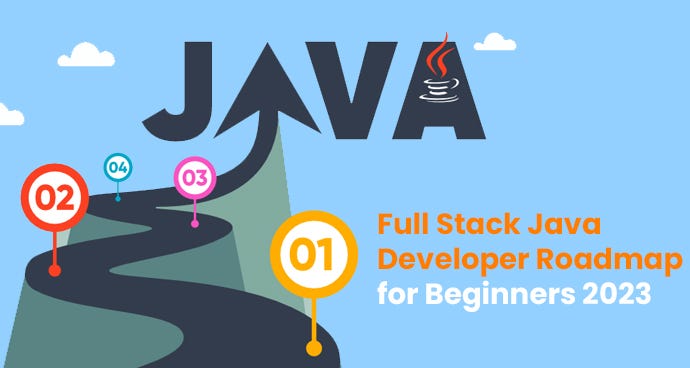
In the ever-evolving world of software development, a career as a Java Full Stack Developer is both challenging and rewarding. Java, a robust and widely-used programming language, serves as the cornerstone for developing versatile, end-to-end web applications. In 2023, the demand for skilled Full Stack Java Developers remains strong. This article outlines a comprehensive roadmap for aspiring Full Stack Java Developers, from beginners to advanced professionals.
Who Is A Full Stack Java Developer?
A Full Stack Java Developer is a proficient programmer skilled in both front-end and back-end development. They possess a deep understanding of Java and work collaboratively with other developers to conceptualize, build, deploy, test, and maintain software applications. These applications span a wide range, including business software, web apps, and websites, all crafted using JavaScript. A Full Stack Java Developer is proficient in both front-end (client-side) and back-end (server-side) modules and must have a solid foundation in database management.
Front-End Module Overview
Front-end development focuses on creating the user interface of web applications. Essential skills include proficiency in HTML, CSS, and JavaScript, with an understanding of JavaScript frameworks like ReactJS, Angular, and VueJS.
Front-End Development Tools and Technologies
The roadmap for Java Full Stack Developers begins with mastering the fundamentals:
- HTML, CSS, and JavaScript: These are the foundational technologies for web development. A solid understanding of these is crucial for building any software application.
- HTML (HyperText Markup Language): HTML is the standard language for creating webpages, defining their structure, and enabling the display of various elements like headings, tables, text, images, and hyperlinks.
- CSS (Cascading Style Sheets): CSS is used to style web content, defining the visual layout, aesthetics, and presentation of web pages.
- JavaScript: JavaScript is a dynamic scripting language that enables interactive web functionality, including content updates, image animations, and user interactions.
JavaScript Frameworks: Angular, ReactJS, and VueJS
To advance your full-stack Java developer journey, it’s essential to learn JavaScript frameworks. The prominent ones include:
- Angular: Angular is a versatile framework for building highly interactive web applications. It enhances HTML syntax to define application components and offers features like dependency injection and data binding.
- ReactJS: Developed and maintained by Facebook, ReactJS is a component-based front-end library. It is renowned for building fast user interfaces for websites and applications. Its component-based architecture simplifies complex UI development.
- VueJS: Vue.JS is a modern JavaScript framework that simplifies web UI creation. It is known for its flexibility, simplicity, and modular architecture, making it easy to learn and use.
Build Tools: NPM & YARN
Understanding build tools like NPM and YARN is crucial for automating tasks, managing dependencies, and streamlining development processes.
- NPM (Node Package Manager): NPM is a package manager for JavaScript that simplifies package management, code distribution, and project dependencies.
- YARN: YARN is another package manager that aims to address speed and security issues in package management.
IDEs (Integrated Development Environments)
IDEs enhance productivity by providing a streamlined coding experience. Popular IDEs include:
- Visual Studio Code: A versatile code editor supporting multiple phases of software development, including task running, debugging, and version control.
- Sublime Text 4: A fast and well-supported code editor that can be customized using packages and configurations.
User Interface Libraries
User interface libraries simplify web development by providing pre-designed UI components. They reduce the need to write extensive custom code for creating aesthetically pleasing interfaces.
Back-End Application Module
The back-end module in the Full Stack Java Developer roadmap focuses on core Java, Java EE, Spring Framework, Spring Boot, Hibernate, and database management. These skills are essential for building the back-end of web applications.
Core Java
Core Java, a fundamental part of the roadmap, includes:
- Object-oriented programming concepts.
- AWT (Abstract Window Toolkit) and Swing for GUI development.
- Collections for managing sets of objects.
- Threading for concurrent processing.
- Java IO Streams for input/output operations.
Spring Framework
The Spring Framework is a critical part of enterprise Java application development. Topics to cover include:
- Dependency Injection.
- Bean Lifecycle.
- Aspect-Oriented Programming (AOP).
- Model-View-Controller (MVC) architecture.
Spring Boot
Spring Boot automates the setup and configuration of Java web applications. It simplifies the development process by automatically configuring application components.
Hibernate Framework
Hibernate, an ORM (Object-Relational Mapping) framework, simplifies database interactions. It helps map Java objects to database tables, making data retrieval and manipulation more efficient.
Database Knowledge
Understanding databases is crucial for back-end development. You should be familiar with:
- MySQL: A popular relational database management system.
- PostgreSQL: A robust and open-source RDBMS.
- MS-SQL Server: Microsoft’s RDBMS.
- MongoDB: A NoSQL database for handling large, distributed data sets.
Other Tools
You’ll also need knowledge of essential tools for a streamlined development process:
- Git: A version control system for tracking code changes and collaboration.
- Docker: A containerization platform that streamlines application development and deployment.
- Jenkins: A CI/CD (Continuous Integration/Continuous Deployment) tool for automated software development processes.
- JIRA: A project management tool that supports Agile development processes.
Conclusion
Mastering the Full Stack Java Developer roadmap will equip you with a diverse skill set that’s in high demand in the software development industry. With expertise in both front-end and back-end technologies, database management, and essential tools, you’ll be well-prepared for a successful career as a Full Stack Java Developer in 2023. As you progress along this roadmap, consider real-world projects and continuous learning to stay current in this ever-evolving field.